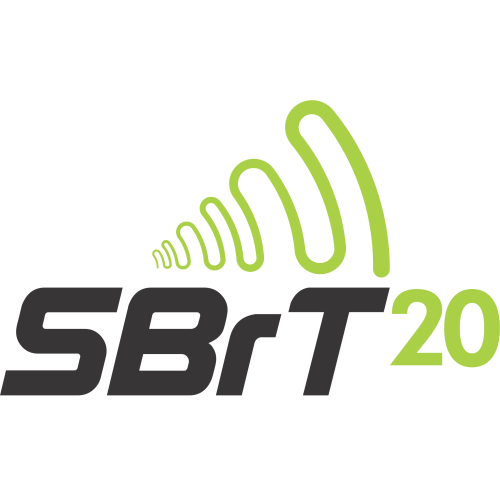
XXXVIII Simpósio Brasileiro de Telecomunicações e Processamento de Sinais

A Modular Parallel-Processing Link-Level Simulator on Python Programming Language
Rodrigo A. R. Fischer, João Paulo Leite, Bruno Faria
DOI: 10.14209/SBRT.2020.1570650150
Keywords: Simulation communications systems parallel computing modular programming
Abstract
Most link-level simulators implement a communication link that can be seen as a particular implementation of a more generic transmission-reception (TX-RX) chain. These simulators also share common simulation capabilities among them. This work presents a technology-independent modular link-level simulator that may be customized with such a generic TX-RX chain developed using the Python programming language. Parallel processing capabilities on its architecture allow the efficient use of the computer's hardware. Also, some processing modules can be further optimized with the use of a specific Python-to-C++ converter package, producing a lower execution time when compared to the use of Python-only features.Download

Implementação e Demonstração de Ataques Cibernéticos em Sistemas SCADA
Camilla E. J. F. Figueiredo, Mikaelly Pedrosa, Iguatemi E. Fonseca
DOI: 10.14209/SBRT.2020.1570650201
Keywords: Smart Grids SCADA MODBUS Cyber-Attacks
Abstract
Inserted in the context of network security in cyber-physical systems, this paper investigates vulnerabilities in communication between devices in a SCADA system and highlights attacks that aim to penetrate it and compromise services provided by a smart grid, which may (if successful) have any purpose, from financial to lethal damage. Therefore, as a methodology, exploratory bibliographic research as well as experimental practical research - implementing some habitual to theses environments, besides contributing with another attack absent in previous works - to obtain a qualitative analysis. As a result, the attacks' effectiveness explored here reiterates system vulnerabilities exploited in real-world scenarios.Download
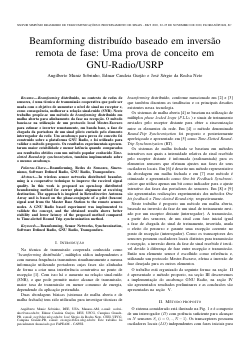
Beamforming distribuído baseado em inversão remota de fase: Uma prova de conceito em GNU-Radio/USRP
Angilberto Muniz Sobrinho, Edmar Candeia Gurjão, J. S. Rocha Neto
DOI: 10.14209/SBRT.2020.1570651733
Keywords: Beamforming Redes de Sensores Sincronismo Software Defined Radio
Abstract
In wireless sensor networks distributed beamforming is a cooperative technique to improve the received signal quality. In this work is proposed an open-loop distributed beamforming method for carrier phase alignment at receiving destination. The approach is inspired in Retrodirective Antenna Array and is based on the phase-conjugate of a pilot (beacon) signal sent from the Master Base Station to the remote sensors nodes. A GNU Radio based experiment was implemented to validate the concept, and the obtained results shows better stability and lower latency of the proposed method compared to Time-slotted Round Trip synchronization method.Download
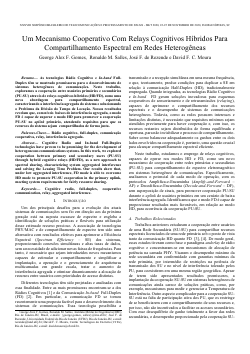
Um Mecanismo Cooperativo Com Relays Cognitivos Híbridos Para Compartilhamento Espectral em Redes Heterogêneas
George A. F. Gomes, Ronaldo M Salles, José F. Rezende, David Moura
DOI: 10.14209/SBRT.2020.1570651756
Keywords: rádio cognitivo full-duplex comunicação cooperativa relay
Abstract
Cognitive Radio and In-band Full-Duplex technologies have proven to be promising for the development of heterogeneous communications systems. In this work, we explored cooperation between primary and secondary users (PU-SU) through hybrid cognitive relays (HD/FD), as a new approach to spectral sharing, characterizing system aggregated interference and solving the Leasing Time Problem. Our results show that, under low aggregated interference, FD mode is able to overcome HD mode to promote PU-SU cooperation in the primary uplink, meeting system requirements for fairly resource sharing.Download
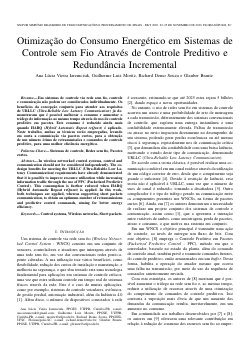
Otimização do Consumo Energético em Sistemas de Controle sem Fio Através de Controle Preditivo e Redundância Incremental
Ana Iaremczuk, Guilherme Luiz Moritz, Richard Demo Souza, Glauber Brante
DOI: 10.14209/SBRT.2020.1570651979
Keywords:
Abstract
In wireless networked control systems, control and communication should not be considered independently. The co-design benefits for meeting the URLLC (Ultra-Reliable Low Latency Communication) requirements have already demonstrated that it is possible to improve resource utilization while increasing information traffic through the use of PPC (Packetized Predictive Control). This consumption is further reduced when HARQ (Hybrid Automatic Repeat reQuest) is applied. In this work, both techniques are applied, whereas supporting short packets communication, to obtain an optimum number of retransmissions and predictive control commands, aiming for better energy efficiency.Download
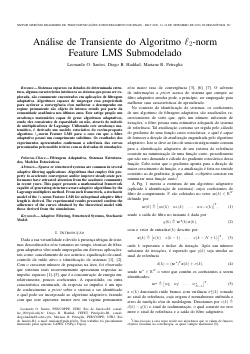
Análise de Transiente do Algoritmo l2-norm Feature LMS Submodelado
Leonardo Oliveira dos Santos, Diego B. Haddad, Mariane R Petraglia
DOI: 10.14209/SBRT.2020.1570652379
Keywords: Filtragem Adaptativa Sistemas Estruturado Modelos Estocásticos
Abstract
Sistemas esparsos ou dotados de determinada estrutura são comumente encontrados em aplicações de filtragem adaptativa. Algoritmos capazes de empregar essa propriedade para acelerar a convergência e/ou melhorar o desempenho em regime permanente são objeto de intenso estudo por parte da comunidade acadêmica nos últimos anos. Este artigo propõe um modelo estocástico capaz de gerar algoritmos adaptativos, sendo eles conscientes de esparsidade ou não, através do método de multiplicadores de Lagrange. Utilizando este arcabouço matemático, é derivado um modelo estocástico do recém-proposto algoritmo l2-norm Feature LMS para o caso em que o filtro adaptativo possui um comprimento subótimo. Os resultados dos experimentos apresentados confirmam a aderência das curvas preconizadas pelo modelo teórico com as derivadas de simulações.Download
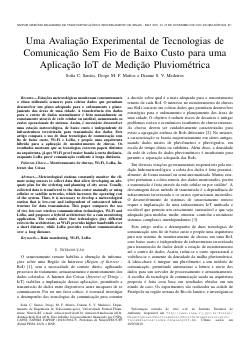
Uma Avaliação Experimental de Tecnologias de Comunicação Sem Fio de Baixo Custo para uma Aplicação IoT de Medição Pluviométrica
Sofia Corrêa Santos, Dianne Medeiros, Diogo M. F. Mattos
DOI: 10.14209/SBRT.2020.1570652620
Keywords: Monitoramento de chuvas Wi-Fi LoRa
Abstract
Meteorological stations constantly monitor the climate using sensors to collect data that allow developing an adequate plan for the ordering and planning of city areas. Usually, collected data is transferred to the data center manually or using cellular or satellite networks, which increases the operating cost of the system. Thus, it is necessary to develop a meteorological station that is low-cost and independent of outsourced infrastructure for data transmission. This paper compares the use of two low-cost wireless communication technologies, Wi-Fi and LoRa, and proposes a hybrid architecture for a rain monitoring application. The results show that technologies play different roles in the architecture, as Wi-Fi provides higher bandwidth over a short distance, while LoRa provides resilient communication over a long distance.Download
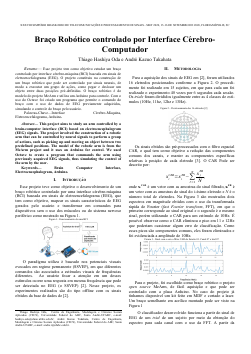
Braço Robótico controlado por Interface Cérebro-Computador
Thiago Hashiya Oda, André Takahata
DOI: 10.14209/SBRT.2020.1570653285
Keywords: Interface Cérebro-Máquina Eletroencefalograma Arduino
Abstract
This project aims to study an arm controlled by a brain-computer interface (BCI) based on electroencephalogram (EEG) signals. The project involved the construction of a robotic arm that can be controlled by neural signals to perform a group of actions, such as picking up and moving an object between two predefined positions. The model of the robotic arm is from the MeArm project and it uses an Arduino for control. We used Octave to create a program that commands the arm using previously acquired EEG signals, thus simulating the control of the arm by the user.Download

Análise e caracterização de luminária LED aplicada em comunicação por luz visível
Fernando César Baraviera Tosta, Marcelo de Oliveira, Alexandre Pohl
DOI: 10.14209/SBRT.2020.1570653437
Keywords: Comunicação em luz visível LED SNR
Abstract
A crescente demanda pelo uso de sistemas de comunicação sem fio, associada a também crescente infraestrutura de iluminação por meio de luminárias LED (diodos emissores de luz), impulsionam estudos para viabilização de sistemas de comunicação por luz visível (Visible Light Communication - VLC). Neste trabalho, é apresentado o estudo de desempenho de um elemento concentrador de luz acoplado sobre uma luminária LED para aplicação em sistemas VLC. Suas características foram reproduzidas e simuladas nos softwares SolidWorks® e APEX®, com a realização de medidas em laboratório, demonstrando a melhora de performance desses sistemas em cenários indoor.Download

Microphone Array Based Surveillance Audio Classification
Dimitri L. O. Silva, Tito Spadini, Ricardo Suyama
DOI: 10.14209/SBRT.2020.1570653439
Keywords: Audio classification Microphone array Support Vector Machine Delay-and-Sum
Abstract
The work assessed seven classical classifiers and two beamforming algorithms for detecting surveillance sound events. The tests included the use of AWGN with -10 dB to 30 dB SNR. Data Augmentation (DA) was also employed to improve algorithms' performance. The results showed that the combination of SVM and Delay-and-Sum (DaS) scored the best accuracy (up to 86.0%), but had high computational cost (≈ 79 ms), mainly due to DaS and DA. The use of SGD also seems to be a good alternative since it has achieved good accuracy either (up to 85.3%), but with quicker processing time (≈ 25 ms).Download